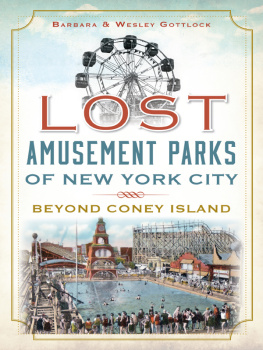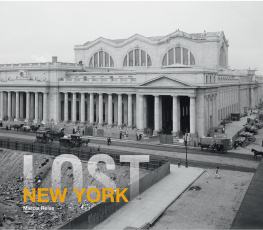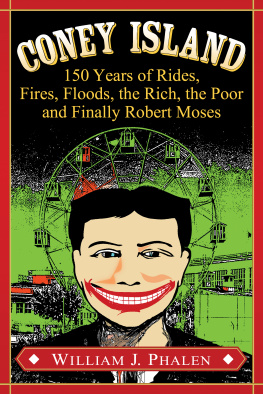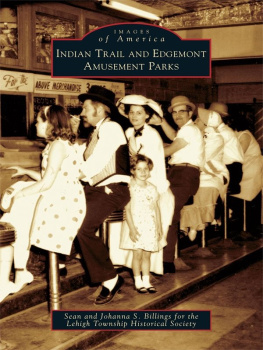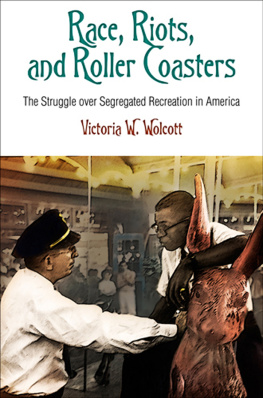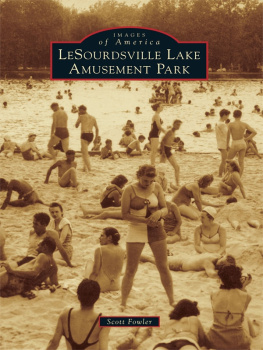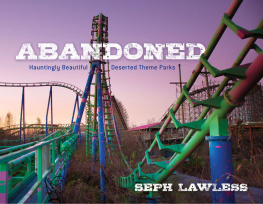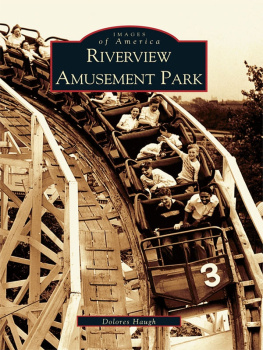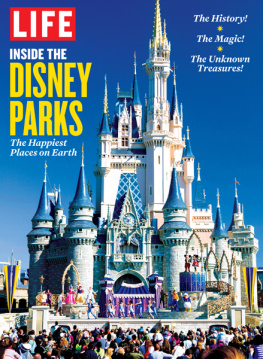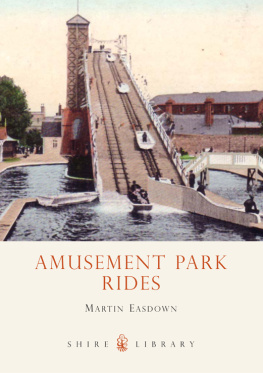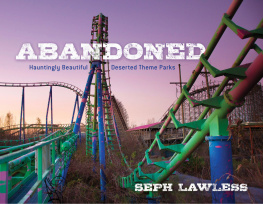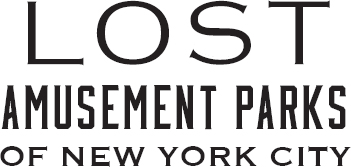
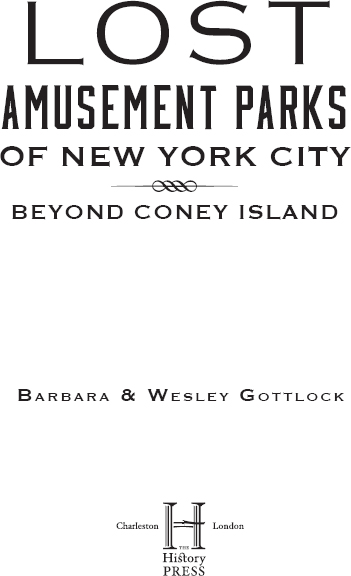
Published by The History Press
Charleston, SC 29403
www.historypress.net
Copyright 2013 by Barbara H. Gottlock and Wesley Gottlock
All rights reserved
First published 2013
e-book edition 2013
Manufactured in the United States
ISBN 978.1.62584.556.6
Library of Congress CIP data applied for.
print edition ISBN 978.1.62619.103.7
Notice: The information in this book is true and complete to the best of our knowledge. It is offered without guarantee on the part of the authors or The History Press. The authors and The History Press disclaim all liability in connection with the use of this book.
All rights reserved. No part of this book may be reproduced or transmitted in any form whatsoever without prior written permission from the publisher except in the case of brief quotations embodied in critical articles and reviews.
CONTENTS
ACKNOWLEDGEMENTS
While researching this project and our previous book about the lost amusement parks along New Yorks Hudson Valley, a whole new world opened up for us. Being relative novices to the genre, we were extremely fortunate to have been assisted by some of the countrys foremost experts in amusement parkrelated niches. Many have spent decades researching the history of parks, roller coasters, Ferris wheels, carousels, vintage postcards and the like. Their willingness to share information and to set the facts straight was not only helpful but inspiring as well.
Three of these individuals deserve special kudos. Fred Dahlinger Jr. of Baraboo, Wisconsin, curator of circus history, Ringling Museum of Art in Sarasota, Florida, provided detailed documentation and images regarding carousels built long ago. Hopefully some of his research methodology has rubbed off on us. Similarly, Norman Anderson, professor emeritus at North Carolina State University, was kind enough to shed light on some of the Ferris wheels discussed in the following chapters. We spent time at the home of Bob Stonehill, whose collection of New York City postcards staggered us. Bob was a willing collaborator, and we cannot thank him enough for allowing us to use many of his cards in this book.
The staff at the Stephen A. Schwarzman Building of the New York Public Librarys local history and map rooms was incredibly helpful and patient. Thanks to all of them.
Wed like to thank Gary Monti, director of Museum and Theater Operations at the Cradle of Aviation Museum/Nunleys Carousel on Long Island, for sharing some history and images of its historic carousel. The folks at the family-operated Clarks Trading Post (www.clarkstradingpost.com) were most helpful.
Once again, we wish to thank the Bronx County Historical Society, particularly librarian Laura Tosi. Also worthy of mention are the Staten Island Historical Society Library, Ira Kluger of the Canarsie Historical Society, Bill Cotter, Bill Brent, the Newburgh Free Library, Thomas Casey and the Friends of Starlight Park. Thanks to all of those who maintain websites related to amusement park history. If one has a need to research almost anything in New York States rich history, youll want to check www.fultonhistory.com sooner rather than later.
At The History Press, we would like to tip our hats to Whitney Landis and Jaime Muehl for their patience and for keeping us on track.
All images in this book, if not cited, are either in the authors collection or in the public domain.
INTRODUCTION
The history of amusement parks somewhat resembles one of their most popular attractions. Metaphorically, its been a roller coaster ride. Not only have amusement parks transformed dramatically over the years, but also the ups and downs of the industry read almost like a good novel. It is worth looking back in time well before the blueprints for New York Citys first parks were finalized.
Amusement parks are generally defined as the generic name for outdoor places of recreation to entertain large groups usually with a collection of rides and other attractions. Their roots can be traced back hundreds of years. Bakken, just north of Copenhagen, is generally regarded as the worlds first amusement park when Kirsten Pill bought land that included natural springs in 1583. The healing power of the springs became the attraction, but soon thereafter various games and other forms of entertainment evolved. Magicians, jesters and jugglers performed. Simple games of chance, music and dancing became typical. Remarkably, Bakken still entertains large crowds each year well over four hundred years later.
By the seventeenth century, European pleasure gardens (or pleasure parks) made their debut. They provided a respite for the masses seeking relief from unpleasant living conditions in growing cities. While the beautifully landscaped gardens and fountains along walking paths were their focal points, other diversions were added to the menu. Beer gardens and food establishments developed. Lawn bowling, tennis and shuffleboard became staples.
New York City had its own pleasure park as early as 1767 with Vauxhall Gardens in lower Manhattan. It was loosely modeled after the historic London park of the same name. Theater, music, gardens, fireworks and other forms of light entertainment filled the park. The term pleasure park held on for many years even after it made its way to America. One of the last usages of the term in New York was the Hudson Valleys Woodcliff Pleasure Park in Poughkeepsie (191741). It hosted the Blue Streak, the worlds highest and fastest roller coaster at the time.
Another pleasure park, Joness Wood, was located in Manhattan from the East River to what is now Third Avenue from Sixty-sixth to Seventy-fifth Streets. It consisted of nearly 150 wooded acres of entertainment. It grew over the years, starting in the first half of the nineteenth century. Its offerings included games of chance, fireworks, shooting galleries, races, animal rides, beer gardens, wrestling matches, picnic areas, food delights and horseback riding. Some of its land was parceled off as time went on, but a huge fire in May 1894 destroyed enough of the concessions, trees and structures (including the stables, where fifty horses perished) to render reconstruction financially prohibitive. Real estate values were climbing in the area, which no doubt hastened the decision to sell the property.
People started seeking more variety in the parks during the nineteenth century. Circus acts, balloon rides and crude thrill rides became more of a lure. It wasnt until the 1873 Worlds Fair in Vienna that the focus of the parks changed from mere relaxation to rides and attractions that offered more excitement. Fun houses, pleasure wheels (the precursor to the Ferris wheel), midways and rudimentary roller coasters made appearances.
But the World Columbian Exposition of 1893 (also known as the Chicago Worlds Fair) had an even greater impact on the evolution of amusement parks. In its six-month run, over twenty-seven million visitors (almost half the U.S. population at the time) were able to observe the latest advancements in amusements. Modern midways, new forms of concessions and ride innovations were introduced. The grand attraction was the debut of the Ferris wheel. The planners of the exposition put out a challenge to anyone who could create a unique attraction to outdo the Eiffel Tower, which was the star of the 1889 Worlds Fair in Paris.
George Ferris, a construction engineer from Illinois, designed a colossal observational wheel that became the centerpiece and the sensation of the fair. The mammoth wheel had a 264-foot diameter and spun its gondolas around on a forty-six-ton axle. Each of the thirty-six gondolas could hold up to 60 people. When filled, the ride held an astounding 2,160 people. Thereafter, Ferris wheels became fixtures at most amusement parks.
Next page
